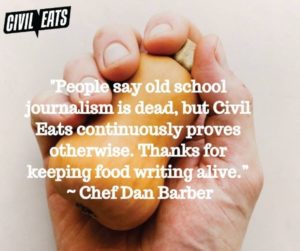Dan Barber
Civil Eats
June 13, 2019How an Oregon Rancher is Building Soil Health—and a Robust Regional Food System
Fourth-generation rancher Cory Carman holistically manages 5,000-acres which serve as a model for sustainable meat operations in the Pacific Northwest.
Carman Ranch began as a few hundred acres Carman’s great-great-grandfather Jacob Weinhard—nephew to the legendary Northwest beer brewer Henry Weinhard—bought for his son Fritz in the early 1900s. Under Carman’s watch, the operation now spans 5,000 acres of grasslands, timbered rangeland, and irrigated valley ground nestled against the dramatic peaks of the Wallowa Mountains. Hawks, eagles, and wildlife greatly outnumber people in this isolated northeastern corner of the state, originally home to the Wal-lam-wat-kain (Wallowa) band of the Nez Perce tribe.
Distinct from most cattle operations in the U.S., Carman’s cattle are 100 percent grass-fed well as grass-finished. (The term “grass-fed” is not regulated, so it can mean that animals have only been briefly pastured before they’re sent to a factory feedlot to be finished.) The ranch primarily produces cattle and pigs, which it mostly markets to wholesale accounts, though it sells a lesser amount of meat as “cow shares”—or quarters of beef ranging from 120 to 180 pounds purchased directly by consumers.
Equally if not more important to Carman, however, is the focus on what she calls the “holistic management” of her land. This involves constantly moving the cattle and paying careful attention to the rate of growth of the animals and grasses. By this system, the steers select the forages they need to grow and gain weight, and the grasses get clipped, trampled down, and fertilized with manure, resulting in fields that are vibrant—they retain water, resist drought, contain abundant organic matter, which contributes nutrients and carbon, and are highly productive without the addition of fertilizer.
https://civileats.com/2019/01/31/how-an-oregon-rancher-is-building-soil-health-and-a-robust-regional-food-system/
Mid-Sized Farms Are Disappearing. This Program Could Reverse the Trend.
A new ‘Ag of the Middle’ program helps small producers scale up so that they can compete in a food system designed to benefit larger farms.
“If we don’t invest in beginning farmers and the advancement of our family farms, and if we don’t put checks on increasing consolidation in agriculture, we’re going to be at risk of losing the ag of the middle entirely,” said Juli Obudzinski, National Sustainable Agriculture Coalition Interim Policy Director, in a recent statement. “Seventy-five percent of all agricultural sales are now coming from just 5 percent of operations.”
Over the years, a number of experts have written books and formed think tanks to address agriculture’s shrinking middle, but as many of the men and women running the remaining mid-sized farms are looking toward retirement, the most important question may be how to best help farmers like the Menchinis grow to take their place.
The Ag of the Middle Accelerator Program from Portland-based nonprofit Ecotrust aims to do just that. The two-year program helps smaller farms, ranches, and fishermen grow to gross between $100,000 to $3 million. And it hopes to build a model that can be borrowed and reproduced all around the country.
Expanding The Shrinking Middle
While there are no hard and fast rules dictating farm size, mid-size operations tend to be regional, somewhat diverse operations that negotiate prices with their customers in restaurant, retail, or at institutions, while large farms are typically less diverse, operate globally, and make millions selling to processors, brokers, or distributors for a price that is set by the market.
https://civileats.com/2019/06/11/mid-sized-farms-are-disappearing-this-program-could-reverse-the-trend/


